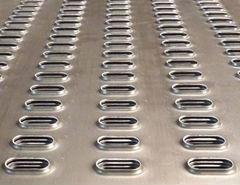Aluminum Trailer Decking

Aluminum decking is a popular choice for trailers, and comes in quite a number of options. Diamond plate, checker plate, or tread plate, whatever you want to call it, is one of the most popular. It is easy to clean, resistant to most chemicals, is long lasting and looks pretty. There are a couple of pattern options for the raised diamond or lines and the slip resistance can differ between them.
Aluminum decking is relatively quick and easy to fit to trailers and if you are able to source sheets of the correct size, can be folded to become a one piece sides and deck (bathtub) unit. This is great if you are towing a lot of loose material or animals as there are no side gaps for material and crap to fall into and makes cleaning a breeze.
Aluminum tread plate comes in a range of thicknesses and depending on the end use 1/8" up to 1/4" are normally suitable.
Flat aluminum sheets without the raised tread plate design are equally at home on a trailer, but beware of slipping and sliding on flat aluminum decking especially when wet.
 Perforated aluminum decking is popular with small earth moving equipment users, lawn mowing contractors and farmers as they have a higher slip resistance for vehicles and animals and are very easy to clean. Perforated aluminum is a good material for trailer ramps, either loose or as hinged rear tailgate ramps.
Perforated aluminum decking is popular with small earth moving equipment users, lawn mowing contractors and farmers as they have a higher slip resistance for vehicles and animals and are very easy to clean. Perforated aluminum is a good material for trailer ramps, either loose or as hinged rear tailgate ramps.
A word of warning if you are using an aluminum decked trailer for transporting firewood, bricks or items with a high point loading. Because aluminum is a soft and ductile material, when aluminum is bent, damaged or dented through normal use, it stretches and deforms and will not retain its original flat surface or shape. If there is not enough decking support or the load placed between the deck supports is excessive, the deck can buckle and deform. When items like firewood or bricks are thrown onto the trailer the buckling will give the deck a skeletal look and if severe enough, will even pop the deck off the fastenings holding the deck to the chassis.
To prevent damage to the deck, you can either fit extra chassis support for the deck or line the deck with a thinner plywood deck before fitting the aluminum.
Aluminum and steel are dis-similar metals and if placed together can generate a mild galvanic reaction where the steel in the chassis can start to corrode rapidly, especially where there is an electrolytic conductor such as water (flung up from wet roads) and in particular salt water (even air borne/salted roads) around.
While galvanized steel and aluminum are not as reactive as bare mild steel and aluminum, there is the chance of some reaction especially around the areas where the deck is fastened to the chassis.
To reduce the reaction it pays to separate the two metals with either applying a bead of neutral cure silicon or rubber tape (or similar) to the trailer chassis before laying the aluminum deck on. This has an added benefit of reducing any vibration and deck noise. Even painted trailers can benefit from having the deck separated from the chassis as the paint under the deck will wear away over time.
Fastening the deck to the chassis is a bit trickier to prevent the two metals touching. If you are really serious about reducing contact, I would drill oversize holes in the deck and apply neutral cure silicon or a similar insulating paste into the hole before fitting the fastener with a rubber/silicon washer. Standard fasteners for fitting aluminum decks to steel chassis’ are hot dipped galvanized screws or at a pinch, alloy rivets.
Zinc plated or stainless steel fastenings should not be used as they will encourage further and faster galvanic reactions.